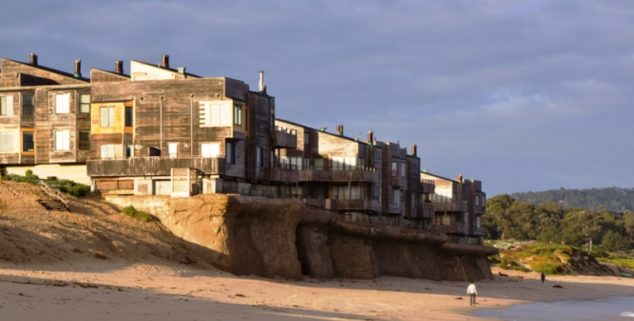News
LAO: Coastal areas should begin preparing for sea level rise
 A seaside condominium complex in Monterey, facing a rising sea level. (Photo: Steve Smith, Shutterstock)
A seaside condominium complex in Monterey, facing a rising sea level. (Photo: Steve Smith, Shutterstock)Editor’s Note: This is an abstract of the executive sunmary of the Legislative Analyst’s report. The full document is available here.
California’s coast could experience SLR ranging from about half of 1 foot by 2030 up to about 7 feet by 2100. Periodic events like storms and high tides will produce even higher water levels and increase the risk of flooding. Rising seas will also erode coastal cliffs, dunes, and beaches which will affect shorefront structures and recreation.
Most of the development along the coast is owned by either private entities or local governments—not the state. Additionally, most land use policies and decisions are made by local governments, and they are most knowledgeable about their communities. Local governments will need to grapple with which existing infrastructure, properties, and natural resources to try to protect from the rising tides; which to modify or move; and which may be unavoidably affected. However, given the statewide risks, the state can play an important role in encouraging and supporting local efforts and helping to alleviate some of the challenges local governments face.
Because many California residents are not yet aware of how and when SLR might affect their communities, coastal adaptation actions are not a high priority…
The progress of SLR preparation across the state’s coastal communities has been slow. Moreover, few coastal communities have yet begun implementing projects to respond to the threat of rising seas. Coastal communities must increase both the extent and pace of SLR preparation efforts if California is to avoid the most severe, costly, and disruptive impacts in the coming decades.
Planning ahead means adaptation actions can be strategic and phased, helps “buy time” before more extreme responses are needed, provides opportunities to test approaches and learn what works best, and may make overall adaptation efforts more affordable and improve their odds for success. The next decade represents a crucial time period for taking action to prepare for SLR.
Local adaptation efforts face several key challenges
Local governments cite funding limitations as their primary barrier to making progress on coastal adaptation efforts.
The novelty of the climate adaptation field makes it hard for local governments to locate and hire individuals with appropriate experience and expertise.
Local governments cite a need for additional data and technical assistance to help inform their adaptation decisions.
Even though the interrelated effects of SLR make cross‑jurisdictional planning essential, local governments lack formal and strategic ways to learn from each other or make decisions together about coastal adaptation issues.
Because many California residents are not yet aware of how and when SLR might affect their communities, coastal adaptation actions are not a high priority for them to request from their local governments.
Achieving regulatory approval for coastal adaptation projects is complicated and takes a long time.
LAO recommendations for supporting local adaptation efforts
While our recommendations represent incremental steps that will not be sufficient to address all the anticipated impacts of SLR, they represent prerequisites along the path to more robust statewide preparation.
Foster Regional‑Scale Adaptation
–Establish and assist regional climate adaptation collaborative groups to plan together and learn from each other regarding how to respond to the effects of climate change.
–Encourage development of regional coastal adaptation plans to address key risks that SLR poses to the region, as well as strategies the region will take to address them.
–Support implementation of regional adaptation efforts by contributing funding towards construction of projects identified in regional plans.
Support local planning and adaptation projects
—Increase assistance for cities and counties to conduct vulnerability assessments, adaptation plans, and detailed plans for specific projects.
–Support coastal adaptation projects with widespread benefits such as those that pilot new techniques, protect public resources, reduce damage to critical infrastructure, or address the needs of vulnerable communities.
–Facilitate post‑construction monitoring of state‑funded demonstration projects to learn more about which adaptation strategies are effective.
Provide information, assistance, and support
–Establish the California Climate Adaptation Center and Regional Support Network to provide technical support and information to local governments on adapting to climate change impacts.
–Develop a standardized methodology and template that local governments can use to conduct economic analyses of SLR risks and adaptation strategies.
–Direct the California Natural Resources Agency to review and report back regarding how regulatory permitting processes can be made more efficient.
Enhance public awareness of SLR risks and impacts
–Require coastal flooding disclosures for real estate transactions to spread public awareness about SLR and allow Californians to make informed decisions about the risks of purchasing certain coastal properties.
–Require that state‑funded adaptation plans and projects include robust public engagement efforts to help develop societal awareness about SLR, build acceptance for adaptation steps, and ensure the needs of vulnerable communities are addressed.
–Direct state departments to conduct a public awareness campaign about the threats posed by SLR to develop public engagement in and urgency for taking action.
Want to see more stories like this? Sign up for The Roundup, the free daily newsletter about California politics from the editors of Capitol Weekly. Stay up to date on the news you need to know.
Sign up below, then look for a confirmation email in your inbox.

Leave a Reply